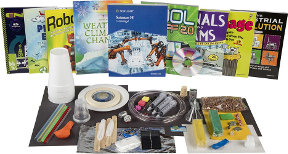Sonlight Science H: Conservation, Robotics, and Technology can be used with students in grades eight through ten. This science course has a STEM (science, technology, engineering, and math) emphasis and features plenty of hands-on activities that students will complete as they read through eight resource books. These eight books are used in the order listed below:
- Robotics: Discover the Science and Technology of the Future (20 projects)
- Cool Stuff 2.0 and How It Works
- Canals and Dams: Investigate Feats of Engineering (25 projects)
- Energy: Why We Need Power and How We Get It (25 projects)
- The Industrial Revolution: Investigate How Science and Technology Changed the World (25 projects)
- Planet Earth: 25 Environmental Projects You Can Build Yourself
- Garbage: Investigate What Happens When You Throw It Out (25 projects)
- See Inside Weather and Climate (Usborne)
The course covers a range of topics—robotics, technology, engineering, energy, the Industrial Revolution, and earth science. Most of these topics are presented from a technology perspective at least part of the time. For example, earth science includes lessons about garbage that focus on the handling of garbage, decomposition, recycling, landfills, and conservation. Within the lessons on energy, students do a home energy audit and learn about the technology of different energy sources such as petroleum, geothermal, nuclear, coal, and solar. While some topics might already be familiar to students from previous science studies, students might be learning about them from a technological point of view for the first time.
A Technology Supplies Kit designed specifically for this course includes a lengthy list of both common and uncommon items such as batteries (9-volt, triple-A, and coin cell), balloons, beads, borax, cellophane, clay, coated electrical wire, cork, copper wire, a mini light bulb and a light bulb holder, oral syringes, straws, tissue paper, and a small DC motor. This kit is included in the complete course package, but you can purchase the required books and gather the science resources on your own if you prefer.
The course has more hands-on activity than most courses for junior high. While lab work is typically scheduled for the fourth day each week, students might be working on lab activities on other days as well. In addition, lab activities are integral to the material students are learning from the books rather than a separate strand.
Reading, hands-on activities, and written work are all directed by the Sonlight Science H: Instructor’s Guide. The Instructor’s Guide comes as a set of three-hole-punched, loose-leaf pages for you to insert in a binder. The Instructor’s Guide has detailed lesson plans for lessons on four days per week. Each week’s lesson plan lists the specific pages to be read each day from the assigned book plus lab activities and activity sheets to be completed. The activity sheets are included within the Instructor’s Guide. (You can order additional sets of activity sheets if you have more than one student.)
Immediately under the schedule for each week is a list of supplies showing those provided in the Technology Supplies Kit you will use plus additional supplies you will need to obtain such as markers, pipe cleaners, Styrofoam plates, a pizza box, cocoa powder, and cotton balls. The additional supplies are also listed a week ahead to give you more time to gather them.
Some lessons are very straightforward and require no additional explanation. However, for many lessons, there are additional notes with essential details in the Instructor’s Guide. For example, for week 19, students are to complete an experiment to power a light bulb using a lemon. While experiment instructions are in the book Energy: Why We Need Power and How We Get It, the additional notes explain that the experiment is generally not successful with only one lemon as described in the book. So Sonlight has rewritten the experiment in the Instructor’s Guide, explaining how to do it using three lemons.
Activity sheets include comprehension questions based on material in the books plus pages for recording and analyzing lab activities. Students work through the steps of the scientific method as they complete lab activities. The activity sheets have questions, charts, and other features to guide them through the steps of the scientific method. Student activity sheets in the Instructor’s Guide are preceded by answer key pages that have reduced images of student activity sheets with overprinted answers.
Internet links in many lessons will be used by students to complete activities or research. For example, in weeks 35 and 36 students will create a weather journal that will include forecasts, current conditions, and recorded conditions for different times of the day. They will be recording wind speed, humidity level, temperature, and average temperatures. They are to search the internet for much of this information and may use suggested URLs for sites such as The Weather Channel—weather.com. Students will note the URLs of sites where they find information, and they will include both text and images in their journal.
This should be a high-interest course because of both the hands-on approach and the practical applications of science within the student's own environment.









